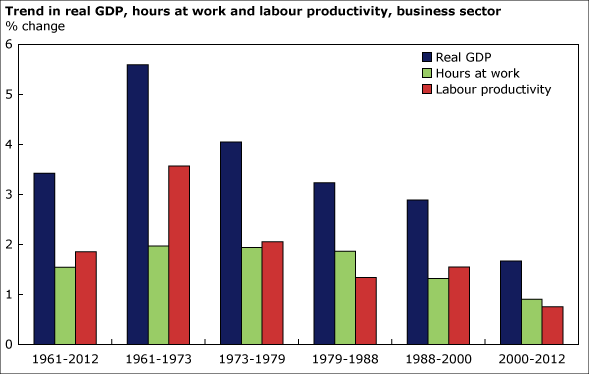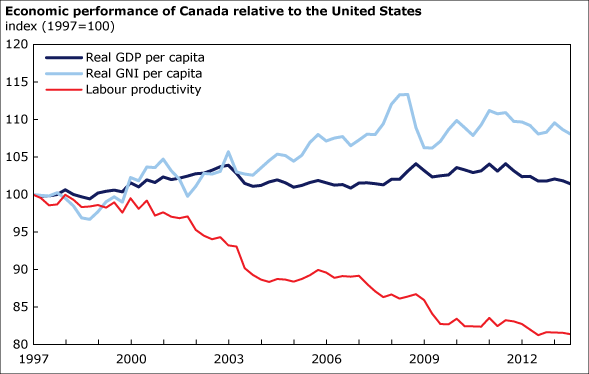Talking productivity
Archived information
Archived information is provided for reference, research or recordkeeping purposes. It is not subject to the Government of Canada Web Standards and has not been altered or updated since it was archived. Please "contact us" to request a format other than those available.
Archived

When John Baldwin, the StatCan productivity expert, stands before a crowd to talk about productivity, he is always aware that it means two distinct things to people in the audience.
To most, productivity has the connotation of working harder. Soon after the turn of the twentieth century, as assembly lines arrived to produce cars and appliances, productivity became synonymous with hard, tedious work in the popular imagination. Think Charlie Chaplin in Modern Times as the little guy caught in the industrial machine.
But for economists and statisticians, productivity is mostly about producing smarter. In simple terms, productivity is a measure of how efficiently inputs are transformed into outputs. Is the business sector taking the inputs that it has and turning them into outputs in a relatively efficient fashion? So productivity is about broad concepts like capital investment and technological change.
Reconciling the two audiences is part of what makes the job interesting. The other is finding agreement in economic circles as to how the concept should be measured. This brings challenges. "The only thing that economists completely agree upon is that productivity should be calculated," Mr. Baldwin says. "There is an ongoing discussion on which methods should be used, how existing approaches could be improved, the extent to which they should be standardized internationally and whether Statistics Canada has adopted the best approach."
In fact, the StatCan productivity team considers itself a research and development group, constantly testing its assumptions and investigating potential improvements in its methodology. "It is incumbent upon us to act professionally by documenting what we do, explaining why particular routes were chosen and consulting with the profession."
Inputs to outputs
At Statistics Canada, productivity is measured several different ways. The Productivity Accounts provide straightforward summaries of the different statistics produced.
The most frequently quoted productivity statistic is labour productivity, defined as the GDP produced per hour of labour worked. It is important because the growth in labour productivity closely tracks the growth in real wage rates—that is, the growth in wage rates adjusted for changes in consumer prices.
Productivity can also be measured by energy productivity—the amount of energy used to create each widget —or by capital productivity, measured by the amount of GDP produced per unit of capital.
A more complex measure produced at Statistics Canada is multifactor productivity. Here, inputs—such as labour, capital and energy—are scooped into a pot and put through some intricate calculations (regressions, multivariate analysis, assumptions and estimates) to generate a measure of multiple inputs to the production process (labour, capital, energy, services and intermediate materials). Multifactor productivity measures are important because they allow analysis of the underlying changes in the economy taking place across all parts of the production process. That enables analysts to better understand the forces that are driving growth.
Other measures
A key message, says Mr. Baldwin, is that productivity is just one measure among many produced by StatCan that economists use to look at the economy. The productivity debate is almost always couched in terms of whether Canadians are better off. But, according to the experts, productivity is only a part of the picture that needs to be considered for a comprehensive analysis of this issue. The summary productivity statistics should be viewed alongside other data that may temper conclusions derived from a productivity measure alone.

For instance, a country's productivity results may look tepid while Gross National Income is increasing at a rapid pace, which has been the case over the post-2000 period. Sometimes, one or two declining industries can depress overall productivity numbers while, in most other industries, productivity growth has been healthy.
In some ways, this caveat applies to international comparisons as well. Other countries are widely thought to earn stronger productivity report cards than Canada does. However, all is not as it may seem on the surface, says Mr. Baldwin.
Overall, productivity in Canada grew at an average rate of 0.76% from 2000 to 2012, compared with 2.32% for the United States.

But keep in mind that Canadian and U.S. statistical systems, while close, are not perfectly comparable. One recent StatCan research project involved crunching Canadian labour productivity data to make them directly comparable to U.S. data. When only large businesses were considered, the gap in the level of labour productivity largely disappears.
By making research an important part of its mandate, StatCan is working hard to incorporate the latest thinking into its programs. Talking to professionals who use our statistics—particularly those who ask the hard questions—is an important part of the process.
Next month: Birthday plans
Login/register to post comments.
Recent posts
-
 1904 people recommended this
1904 people recommended this -
 2551 people recommended this
2551 people recommended this -
 2925 people recommended this
2925 people recommended this
- Date modified:
User comments
Interesting post. Are there available productivity measures that try to take into account black market transactions?
While we have experimental estimates of the size of the underground economy, they are not incorporated into the Productivity estimates that use official estimates of output that do not include the underground economy.